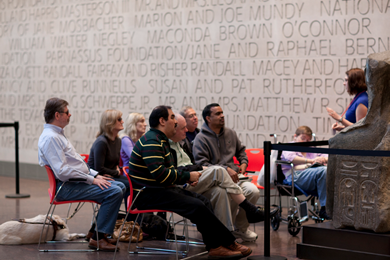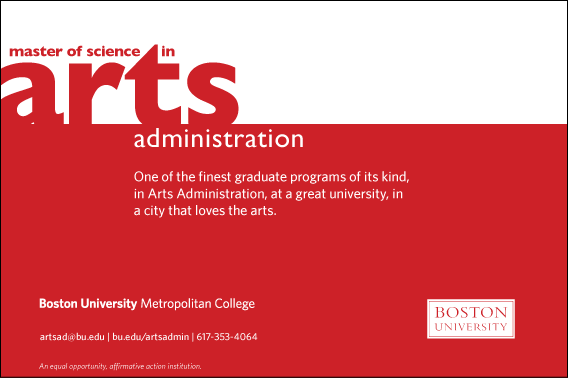
Training Over Technology: An Easy, Low-Threshold, First Step Towards Access
Phillippa Pitts, Kress Interpretive Fellow, The Portland Art Museum, Portland, OR
Phillippa Pitts is the 2013 NEMA Conference Fellow. As part of the fellowship Phillippa wrote a series of thought leadership articles for the NEMA community.
When it comes to access in museums, the array of available assistive technology is incredible. Induction loops transmit clean, crisp sound from a speaker’s microphone to a visitor’s cochlear implant. Apps scan paintings and read out their colors. iPads allow visitors who would previously have been considered nonverbal to add their voices to the conversation.
Together, these innovations present an overwhelming array of potential avenues into our collections and programs for those who had previously been excluded. However the selection is just that: overwhelming, as well as ever-shifting and expensive. Access can become something which is not in the budget, too demanding of staff resources, and too intimidating to even begin.
Yet, across the board, the most effective change that can be made is the least expensive and lowest-tech: staff training.
Access isn’t available in one size fits all. Every visitor approaches the museum with a different set of needs, desires, and interests. Even within a single type of disability, there is enormous variance. People who have low vision may be able to perceive color but not depth. Some may be light sensitive, others unable to see in the dark. One may have been blind since birth, another sighted until very recently. These visitors vary in their level of vision, history of vision, needs and preferences, inclination towards advocacy, and involvement, interest and knowledge of the given museum’s subject matter. As such, there is no single best program or technique to meet the needs of all: a range is required. Given the rapid and continuing evolution of assistive technologies, as well as the heterogeneity of their implementation, it can feel daunting to keep current with the range of options required to meet visitors’ needs.
On the other hand, training front-line staff is a low-threshold, first step which draws its strength from its flexibility. To return to the example of visitors with low vision, verbal description’s purpose is to convey and describe the visual in nonvisual language. As such, it can be used to describe anything from a work of art to a traffic circle, a dance performance to an X-ray. It is a technique, not a pedagogy. It can be responsive to the visitor’s questions. It could even be the basis for facilitating an observation-based, participatory group tour, as the Museum of Fine Arts, Houston recently demonstrated (Hoyt, 2013). Despite common misconceptions, most “visualizing” is, in fact, spatializing: imagining space and form. It can be done if you are blind and it can be done if you have sight (Art Beyond Sight, 2004). Although most constructivist educators take for granted that dialogue, participation, and personal meaning making are crucial to learning, many forget those core lessons when working with visitors who are blind or have low vision.
By combining verbal description with existing, proven pedagogies such as layering information or paraphrase, a skilled educator can create the same participatory space, bringing together everything that can be seen, felt, imagined, or reasoned about an object or topic. Such an enhanced process benefits all visitors. It guides them in their looking and models long, deep interactions with a single object. Its provides extra information, such as the height of a tall object, that may be of interest to all. Its tools, such as tactile props, may benefit those with different learning styles. By training all educators in these techniques and integrating them into everyday practice, the dynamic changes from an “opt-in” experience to an “opt-out.” As such, it takes the onus away from the visitor to identify themselves. It also meets the needs of visitors who might not even self-identify as having vision loss, common among older adults.
Verbal description also impacts the educator, requiring imagination and vivid language. As one professional notes, “an active describer must increase his level of awareness and become an active “see-er” (Snyder, 2005). As such, educators are more likely to communicate using metaphors and schema, which allow the visitor to grasp a general concept quickly and then refine it, increasing their retention and comprehension (Heath and Heath, 2008). Training in access improves their overall practice.
Moreover, much as an educator should be versatile enough to work with visitors of different reading levels, different cultural backgrounds, or even different opinions, so too should educators be given the tools to work with visitors of all levels of abilities. It is not enough to sequester people with disabilities into their own programs, to place their care in the hands of specialists or designated individuals.
Visitors do not distinguish between paid educators and docents, museum baristas and ticket takers. All are museum staff, and all are representative of their institutions. The behavior of front-line staff is one of the most impactful determinants of an experience for visitors with disabilities (Reich et al, 2011). Friendliness and courtesy are insufficient. Staff need knowledge of museum resources and policies and training in how to offer assistance and listen to needs. Training programs can dispel myths that blind people never leave their houses or that a visit to the museum is their only social life. People-first language helps staff see the visitor, not their disability. Comfort and confidence dispel conflict when, inevitably, perfection proves impossible. Elevators will break. Ramps will be icy. What front-line staff should have is the training to navigate these situations with care, politeness, and respect instead of misplaced compassion and pity.
The impacts of this low-threshold, first-step are disproportionately large. Seeing a visitor with a disability accessing, learning from, and enjoying their experience in the museum is a gateway drug. It inspires staff to look at what they are doing and how they could do more. The more that offerings expand, the more visitors come in. The more visitors who come in, the greater everyone’s comfort level becomes. Success creates a positive feedback loop which has the potential to spiral and grow.
The result extends beyond simply making our institutions into better spaces for a new target demographic. We have the opportunity to take an active role in a major twenty-first century civil rights issue, in which access transcends ideas of legal compliance and becomes the moral imperative that it is. Making ourselves not only inclusive but visibly inclusive is to become a place where people engage with new visions of ability and combat the socially determined elements of health and disability. By taking a small first step, our staff learn. Our visitors learn. And people with disabilities learn that they have an ally in us.
This work has already begun in our New England community, led by museums of all sizes and types. Each year at our annual conference, sessions highlight new innovations, partnerships, and strategies for providing access. Make this the year that you join a session.
Works Cited
Art Education for the Blind. Online Accessibility Tools Training. Art Beyond Sight, 2004. Accessed online at www.artbeyondsight.org/handbook/acs-onlinetraining.shtml
Heath, Chip and Dan Heath. Made to Stick: Why Some Ideas Survive and Others Die. New York: Random House, 2008.
Hoyt, Bridget O'Brien. "Emphasizing Observation in a Gallery Program for Blind and Low- Vision Visitors: Art Beyond Sight at the Museum of Fine Arts, Houston." Disability Studies Quarterly 33, no. 3 (2013).
Smith, Heather J. L., Barry Ginley and Hannah Goodwin. "Beyond Compliance? Museums, disability and the law." In Museums, Equality and Social Justice, edited by Richard Sandell and Eithne Nightingale, 59-71. New York: Routledge, 2012.
Snyder, Joel. "Audio description: The visual made verbal." International Congress Series 1282 (2005): 935-939.
Reich, Christine, Anna Lindgren-Streicher, Marta Beyer, Nina Levent, Joan Pursley, and Leigh Ann Mesiti. "Speaking Out on Art and Museums: Study on the Needs and Preferences of Adults Who Are Blind or Have Low Vision." Art Beyond Sight. New York: Art Education for the Blind, 2011.
Image: Museum of Fine Arts, Houston Verbal Description Tour
